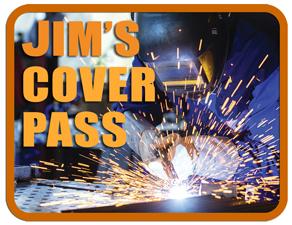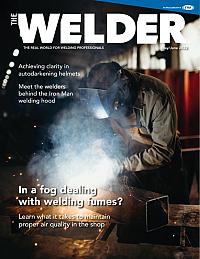Senior Company Trainer
- FMA
- The Fabricator
- FABTECH
- Canadian Metalworking
Categories
- Additive Manufacturing
- Aluminum Welding
- Arc Welding
- Assembly and Joining
- Automation and Robotics
- Bending and Forming
- Consumables
- Cutting and Weld Prep
- Electric Vehicles
- En Español
- Finishing
- Hydroforming
- Laser Cutting
- Laser Welding
- Machining
- Manufacturing Software
- Materials Handling
- Metals/Materials
- Oxyfuel Cutting
- Plasma Cutting
- Power Tools
- Punching and Other Holemaking
- Roll Forming
- Safety
- Sawing
- Shearing
- Shop Management
- Testing and Measuring
- Tube and Pipe Fabrication
- Tube and Pipe Production
- Waterjet Cutting
Industry Directory
Webcasts
Podcasts
FAB 40
Advertise
Subscribe
Account Login
Search
Jim's Cover Pass: Dealing with leadership change in the weld shop
How can a manager calm employees fear, concern, and temper their initial resistance to change
- By Jim Mosman, AWS, CWI/CWE
- June 14, 2022
- Article
- Arc Welding
Q: Our company has been going through several organizational leadership changes affecting the implementation of welding procedures and work directions. Do you have any suggestions to help better understand the employee response to these changes and how I can keep my team positive and on board?
A: As the saying goes, the one thing that remains constant is change. These last few years have really made that statement seem somewhat overwhelming. A stagnant company that continues to do things “the way they've always been done” is asking to be left behind. Here are a few suggestions to help your team work through change.
The first reaction most employees have is denial. They don’t want to accept change or the enforcement of new procedures. Their next response oftentimes is anger and resistance. The questions “Why is this change being made?” and “What was wrong with the way we always did it?” will surface and become break room chatter. Some employees will undoubtedly resist and become more vocal than others.
What most employees feel is fear of the unknown and a resistance to change, especially when it comes to their daily workplace. Oftentimes this stems from employee concerns and fears of how this change will affect their jobs and employment status.
This is where good managers can help ease this transition. The best plan of action is to provide a clear line of communication between all parties. Asking for suggestions and feedback is important to the process. Provide a clear message that describes the advantages and growth opportunities that will be available.
Another helpful idea is creating a timeline that shows when new procedures will be implemented. This timeline also should include employee training and a trial period to work through the details.
The final stage is acceptance. When the results are positive and include increased production, better working conditions, improved company relations, and continued company growth, most employees will begin to support the new ideas.
And for those who continue to resist and refuse to accept their new responsibilities? Perhaps they’ll be better off working for your competitor down the road.
About the Author

Jim Mosman, AWS, CWI/CWE
Lincoln Electric Education Division
About the Publication
Related Companies
subscribe now

The Welder, formerly known as Practical Welding Today, is a showcase of the real people who make the products we use and work with every day. This magazine has served the welding community in North America well for more than 20 years.
start your free subscription- Stay connected from anywhere

Easily access valuable industry resources now with full access to the digital edition of The Fabricator.

Easily access valuable industry resources now with full access to the digital edition of The Welder.

Easily access valuable industry resources now with full access to the digital edition of The Tube and Pipe Journal.
- Podcasting
- Podcast:
- The Fabricator Podcast
- Published:
- 04/16/2024
- Running Time:
- 63:29
In this episode of The Fabricator Podcast, Caleb Chamberlain, co-founder and CEO of OSH Cut, discusses his company’s...
- Trending Articles
Sheffield Forgemasters makes global leap in welding technology

ESAB unveils Texas facility renovation

Engine-driven welding machines include integrated air compressors

How welders can stay safe during grinding

The impact of sine and square waves in aluminum AC welding, Part I

- Industry Events
16th Annual Safety Conference
- April 30 - May 1, 2024
- Elgin,
Pipe and Tube Conference
- May 21 - 22, 2024
- Omaha, NE
World-Class Roll Forming Workshop
- June 5 - 6, 2024
- Louisville, KY
Advanced Laser Application Workshop
- June 25 - 27, 2024
- Novi, MI




























